It all started when I bumped into an old
friend that I hadn't seen for some time. Over more than a few
beers it transpired that he had been involved with a band called
Subt Lemon for a couple of years and they were at the point of
recording an album of original material. I suggested that we
could cooperate on a promotional video for the band. I had been
running a media department for a large company for the previous
two years and had always thought that I would like to work on
a project like this as it was far removed from the corporate
videos and multimedia projects that I had been involved with.
Over the next few weeks we set
about trying to plan how we would do it and also kicked about
a few ideas on what song would be used and what the story would
be about.
One thing we learnt very early
on was that the video story had to be do-able; there was no point
in creating some fantastical story line with special effects
and a cast of thousands as it just would not happen. All the
guys involved in the band and the technical helpers work full
time and it would be a miracle if we could get them all together
for more than a few hours at a time.
The concept
After a few weeks we came up with the concept for the storyline
and a plan for how we could complete the project. An idea was
floated early on that the story could be about one guy following
another guy; the idea would be that the audience wouldn't know
till the end why he was being followed. This would be intercut
with studio footage of the band playing and other shots that
could be connected to the main theme or would even be used as
red herrings in the narrative to grab attention. The song that
was picked, 'Too Close for Comfort' was ideal as it gradually
builds up power, so we could then match the dynamics of the song
with the visuals and build up the tension as the video reached
the end.
We came up with the following conclusions:
- We should stay away from a literal
approach to the lyrics; there would be no point in trying to
lock the listener into the director's view of what the lyrics
were about.
- We should approach the video from
an experimental point of view and improvise scenes and shots
if they seemed to work.
- At the end of the day it was the
band that was being promoted not the video.
- There were to be no extraneous
narrative, characters or words and we should try to create a
'feel' more than a logical narrative structure.
- The video should be edgy enough
to be noticed and should have layers of texture and complexity
- it should also be able to stand up to several viewings.
- We would depend on emotion rather
than character or plot development.
- We decided that we would go for
a grainy over-saturated look to the final video production.
And if we were very lucky the synergy
of the combination of song and visuals would enhance the viewer's
overall experience. There is little room for manoeuvre as the
video has to fit the music; I have now come to realise that there
is certainly a craft and a discipline in making this type of
video, almost akin to the art of the short story.
We used the following equipment
and software:
Apple G4 667Mhz Powerbook
Canon XL1 DV Camera
Nikon D100
Maxtor External 80Gb Fire wire Drive
Lacie external DVD writer
Final Cut Pro 3
Joes Filters
After Effects
FilmFX
IView MediaPro
Story Board Quick
Quick Time 5
Propeller Head's Reason 2
Cleaner
DVD Studio Pro
The Storyboard
Once the theme had been fleshed out we started storyboarding
and looking for locations. The way we did this was to use a Nikon
D100 and to place ourselves into the locations as the actors
would appear taking lots of small JPEG images. These were then
organised in iView MediaPro, made into QuickTime presentations
and then circulated to the band and any other interested parties
for comment.
We went around this loop several
times and the storyboard gradually evolved as we found locations
were unsuitable to use for various reasons. One problem we had
early on was trying to set up a particular pub location for some
interior shots and coming up against a brick wall. Without the
prospect of payment of hundreds of pounds, the management just
were not interested. We finally found a very cooperative and
friendly couple in the form of Tony and Pauline Lock of the Pelton
Arms in Greenwich. They were more than happy to oblige, even
letting us in early on a Saturday morning to film the interior
shots. The storyboard finally hit version 4 and it was then transferred
into an application called Story Board Quick for final agreement.
I cannot over emphasise the importance
of storyboarding, as it's the only way you can organise your
shots and effectively communicate your ideas to other people.
Although we ended up with a video which was about 30% of the
final storyboard, it did enable us to plan and manage what we
were doing.
The Shoot Morning One
The video was to be shot over two Saturday mornings and two evenings.
The first location was the interior and exterior of the Pelton
Arms. A date was set and we started trying to persuade friends
to be extras, the promise of free beer and a lunch certainly
helping.
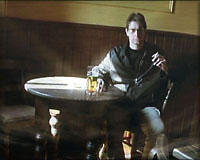
Alex Heinke in the
Pelton Arms
As the day approached the weather
was changeable and several extras had pulled out. It all looked
pretty gloomy and it was fifty-fifty whether we would go for
it. We had already decided that Steve, the band's singer, and
Alex, another freind, would be the main characters. We took a
gamble and at the eleventh hour a few more extras turned up,
the weather stayed remarkably dry and sunny and we had our first
shots in the can.
Shooting the Pelton interiors
I thought I would use the tripod more than I did but I found
a monopod much more useful and with the image stabilisation on
the Canon XL1 the shots were fairly stable.

SID from Subt Lemon
in the Pelton Arms
We only used natural light inside
the Pelton and because we were trying to get a burnt out look
to the sky and external shots through the windows it didn't matter
that we never used artificial lighting inside. But do make sure
that you visit the location at the same time you want to shoot
about a week before you shoot just to make sure that the sun
won't be facing into your camera lens or there is some other
nasty lurking in the shadows.
Shooting the Pelton Exteriors
We planned to do a set up shot with a motor bike that was going
to come to a screeching halt just in front of one of the actors.
About an hour was spent on what appeared to be a simple four
shot sequence but like all the other 'clever stuff' we attempted
over the first two locations it ended up on the cutting room
floor. At the end of the day none of the guys in the production
are actors and we were asking them to do things which they were
not trained or experienced in This is an interesting area and
demonstrates why you should keep things very very simple.
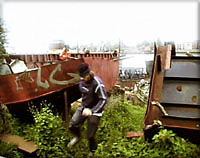
SID on the Run by
the river Thames
There are ways of creating mood
and understanding from sequences of managed shots and editing
techniques and a study of the Russian Director Lev Kuleshov and
his use of the juxtaposition of images and montage is very useful.
The Shoot Morning Two
Even in a small production like this, continuity is an important
factor and although everyone had a snapshot of what they were
wearing, state of hair, shaven or not, make up etc after the
first shoot, someone went and lost the main character's hat.
This resulted in searching the web for a supplier; one was eventually
found and purchased. It's a good idea to keep all these small
'losable' props in one box and let one person have the responsibility
for it.
The weather could have posed other
problems as we really wanted continuity in the external light
over the two shoots. We were very lucky with this and the weather
stayed fine. But these areas of continuity do require managing
and it's very useful to build contingency into your planning.
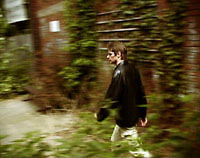
Alex catching up
Another set piece which we took
an hour to complete later also ended up on the cutting room floor.
As on the first day's shoot the storyboard was invaluable and
enabled us to move through the locations quickly and to frame
the shots as planned with everyone knowing what they should be
doing.

All over for SID
At the end of the second shoot
we transferred all of the DV video footage to VHS tape for viewing
by the team and when we had agreed on what takes would be used
these were then captured to the Powerbook and then archived to
the Maxtor 80Gb external Firewire disk drive and 4.7 Gb DVD disks.
The Shoot Evening One
The first evening shoot was at OTR Studios at Hackney. It was
a sweltering night and stuffy inside the rehearsal room. There
was no natural light of any type inside the room and for an hour
the lighting that we had borrowed refused to work.

Subt Lemon at full
throttle
Finally the lights burst into life
and we started the ten mimed takes we needed to give us enough
material for the band sequences. We required enough cutaways
to take care of any problems that we might come up against later
in post-production. The band shots would be cut into the story
and these would probably come in and out on the beat, but until
we had finished all the shoots we didn't really know where these
would fit in. The Band mimed to a CD version, which was eventually
deleted from the visuals.
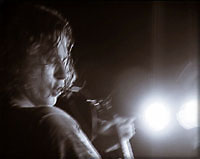
SID in the spotlight
When these had been completed I
layered all of the ten takes in Final Cut Pro 3 and lip-synched
them together. Once this was complete I turned layers on and
off to try to get an indication of which takes were the best
and then created a rough edit of a studio video. I locked all
these synchronised layers, deleted the original audio and overlaid
the CD track that had been used at the studio. When I came to
insert the studio footage into the main project it was a simple
matter of turning it into B and rendering the studio video project
in FCP, later importing it again as one clip into the main FCP
project.

SID Blasting out
the vocals
The Shoot Evening Two
We had one more shoot which was to be done at one of the band
member's houses. At this point I was wondering where the first
cut would be made and how the video would actually start.

Fran is 'Too close
for comfort'
We felt that a hook should be put
in early on to grab the audience's attention. This later turned
out to be the girl (Fran) with the knife walking in slow motion.
This shot is also repeated later in the video and runs at normal
speed. We also decided to create a soundscape comparable to the
mood of the song with some opening music chords and sound effects.
These would run over the titles and into the opening shot where
the band actually starts playing.
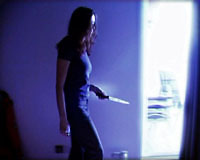
Fran up to no good
This last shoot roughly followed
the storyboard although we took the opportunity to improvise
with some unplanned and spontaneous shots. Some of these were
actually used in the production.
Post Production
We ended up with two and a half hours of footage, which was finally
whittled down to an 8 minute video. This included the titles
the introduction, song, closing credits and some footage of the
making off the video.
I captured the takes that we were
going to use in Final Cut Pro. The video clips, audio and graphics
files took about 20Gb of space on the PowerBooks 40Gb disk drive.
These source DV files were then backed up to the Maxtor Fire
wire drive and to DVD. Its imperative to have a logical file
naming convention and stick to it. Also a control of the various
project files can become a headache. Each DV source file was
given a descriptive name eg 'Al and Steve walking location 3'
and project files were listed as project 1 date 060703 and so
on. I kept a small spreadsheet with the file name and its content.

If SID thought it
was all over.......
By now I had become very familiar
with the song and felt that the best way to put it together was
to use an instinctive and intuitive approach. The storyboard
told me what the sequence of shots should be - I just needed
to tap into the rhythms of the song and to let that dictate the
perfect length of the shot whether it be cutting on or off the
beat or something else. It's important to wear high quality headphones
when editing as you can hear all the subtle nuances in the make
up of the track. The vocal will always have cue points that match
the underlying rhythms, but will also have its own cue points,
which you can use to cut on or off the beat.
Music videos are not about subtlety,
they're about grabbing the viewer's attention. Every shot has
to be 'on the money' - this is the craft of the music video.

........It is now
!!!
When the rough edit had been completed
it was aired to the band for approval. We ended up making some
cuts to speed up the pace at the end and then concentrated on
getting the look that we wanted. A simple 3 note motif created
in Reason was placed over the opening titles and introduction
to create a moody opening section.
I rendered a full Pal-DV stream
and re-imported it into a new FCP3 project then:
- Changed the gamma to increase
the contrast of the mid tones without blowing the highlights
and shadows.
- Applied a colour glow filter from
the 'Joes Filters' range. This bleached out any white areas like
sky detail and light coming through windows.
- Rendered another version and imported
that into After Effects 5 and, using a AE5 film-look plugin called
Film FX, applied an oversaturated film look and grain to the
file which was then rendered out.
Three versions where then made.
- A broadcast quality DV tape version
with PAL bars and tones and a countdown clock. This can also
be converted to Beta SP, Digi Beta or VHS tape.
- An MPEG 1 conversion to run on
Windows and Macintosh PC's.
- An MPEG 2 conversion to run on
a DVD.
We have learnt an incredible amount
from this project especially about what is and isn't possible
when you have no money available to spend. As well as distributing
the video amongst the Subt Lemons fan base it is an ideal promotional
piece for the Album, which is to be released in October, and
we have already submitted to a TV network for possible inclusion
in a rock video programme. We are now in the process of planning
a second video, which we are hoping to finish by the end of the
year.
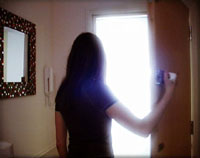
Fran answers the
door
Graemewebb@mac.com
After getting bored working in the IT industry Graeme went to
work for a media department in a European telecoms company, Producing
Web, video, Macromedia flash and photographic presentations for
corporate and training puposes. The opportunity arose to take
redundancy which he accepted with relish and now he pursues his
passion for photography and Video through his small company Amberwood
Media. In his spare time he can be found drinking cider or tequila,
listening to rock music and jazz on his Apple IPod or watching
David Lynch and Cohen brothers films. Graeme lives in a shady
suburb of London with his partner Gill and 3 Apple Macs.
Subt
Lemon Web Site Music tracks from
the new album "Nice Try"
copyright © Graeme Webb 2003
This article first appeared on www.kenstone.net and is reprinted here
with permission.
All screen captures and
textual references are the property and trademark of their creators/owners/publishers.